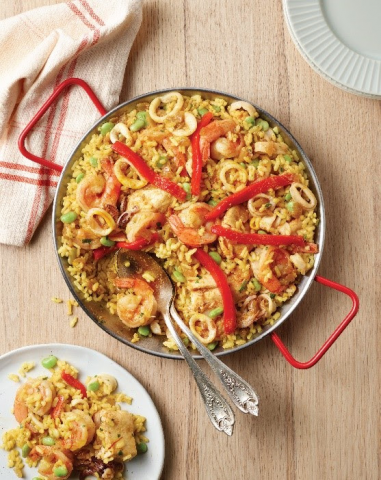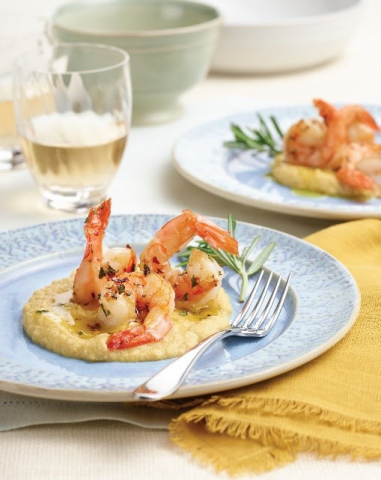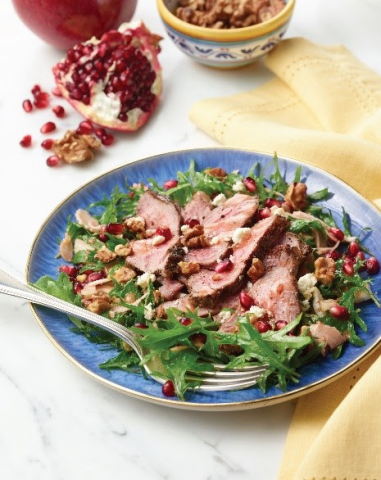


Most of us treat mealtimes as an afterthought. We grab breakfast on the go, inhale fast food lunches at our desks, and squeeze in evening meals amid a flurry of activities. We're lucky if we find time to sit down for Sunday dinner or meet friends for a midweek catch-up meal. But overall, communal eating is the exception, not the rule.
This needs to change for the sake of our health and our happiness. And since February 15 is National No One Eats Alone Day (an initiative to help middle school students feel included, valued, and accepted by their peers), now is the perfect time for us all to embrace more shared meals.
Eating alongside other people has many proven health and social benefits. Communal eating is a long-upheld tradition in Mediterranean communities, where people live longer and enjoy great health. Americans can greatly benefit from adopting these practices and enjoying the foods eaten in this region.
You've likely heard of the Mediterranean diet, which was just named best overall diet of 2019 and is linked to preventing heart attacks, strokes, and diabetes; longevity; and reducing inflammation. This eating pattern focuses on seasonal produce, fish and seafood, poultry, eggs, dairy, and small amounts of meat and sweets.
When combined with lifestyle choices like communal eating and physical activity, the Mediterranean diet is believed to contribute to remarkable longevity in the region. For example, residents in Sardinia are ten times more likely to live past 100 than people in the United States. Researchers attribute this to daily communal eating and the psychological security of being surrounded by loved ones. But every country and culture in the Mediterranean region has its own way of encouraging people to plan meals and eat together, and this tradition also has been linked to improved digestion and eating less overall.
Eating more shared meals can be difficult given our demanding work schedules, but the benefits are truly worth the effort. Even when it isn't possible to be with someone else, you can send a message to a loved one and arrange to call via Facetime or Skype when you're eating.
Starting your own tradition of eating with friends and family is easy to do. Here are a few simple ideas to help you enjoy more meals with others:
Schedule meals with others into your weekly planning. Just as we plan going to the movies, working out, carpooling, the theater, or spectator sports with one another, we should also plan our meal times and physical activity. Even if you start with just one meal a week, it is worth it to pencil it into your schedule so you can plan accordingly.
Remember, communal meals don't have to mean dinner. Many people have the most interaction with others during their work day—so lunchtime is a great time to eat together. Ask your coworkers to join you for your midday meal or invite a friend to lunch.
Make breakfast the new dinner. You can bond just as easily over breakfast as you can over dinner. Busy couples and families are taking advantage of a communal breakfast to enjoy a bit of time together before their hectic days begin.
Allow cooking to be part of the communal eating experience. Some people refrain from entertaining because they believe that they have to have everything "ready" for whomever they're eating with, and busy schedules don't allow for prep work. If you can relate, keep in mind that it can be fun and efficient to work as a team. Assign one person the responsibility to pick up the groceries—or order them online—and cook together. It allows for more communal time in the kitchen.
Now that you're ready to sit down and enjoy a healthy and delicious meal with others, keep reading for a few Mediterranean recipes:
Valencian Seafood Paella (Arroz en paella)
Gluten-free
Serves: 8
Serving size: 1 cup
Prep time: 10 minutes, plus 10 minutes resting time
Cook time: 40 minutes
Paella is known as arroz en paella in its homeland of Spain. Original paella recipes consisted of rabbit, chicken, snails, and beans. The paella pans were rubbed in ash and cooked over orange wood. This "party in a pot" is said to be a descendant of Arabian kabsah, a similar dish originating in the Arabian peninsula. Arabs introduced rice into southern Spain in the ninth century, along with spices like saffron.
2 Tbsp extra-virgin olive oil
1 yellow onion, diced
1/4 lb jumbo shrimp, peeled and deveined*
1 lb baby squid, cleaned and sliced into rings
1/2 lb boneless white fish fillets, such as cod or swai
1 1/2 cups medium-grain Spanish rice
1/2 lb frozen lima beans, thawed and drained
Pinch high-quality saffron
2 tsp sweet paprika
1 clove garlic, chopped
2 Tbsp fresh flat-leaf parsley, finely chopped
5 cups Homemade Seafood Stock (p. 37)
1/2 tsp kosher salt
1/4 cup jarred pimiento peppers
Heat oil in a large, wide skillet over medium heat. Add onion and cook until golden brown (about 5 minutes). Add shrimp, squid, and fish to pan. Cook until barely opaque. Add rice and lima beans, and stir in saffron, paprika, garlic, and parsley. Pour the stock over the top of the mixture and add salt. Increase heat to high to bring to a boil, then reduce heat to low and stir.
Cook paella, uncovered, for 30–40 minutes or until all liquid is absorbed, stirring occasionally. When paella is done, allow to stand at room temperature for 10 minutes. Garnish with pimientos, and serve warm.
*If possible, use fresh (never-frozen) shrimp or shrimp that are free of preservatives (for example, shrimp that have not been treated with salt or STPP [sodium tripolyphosphate]).
Choices/Exchanges
2 1/2 Starch, 2 Lean Protein
Calories 280
Calories from fat 40
Total fat 4.5 g
Saturated fat 0.8 g
Trans fat 0.0 g
Cholesterol 145 mg
Sodium 240 mg
Potassium 360 mg
Total carbohydrate 39 g
Dietary fiber 3 g
Sugars 1 g
Protein 20 g
Phosphorus 220 mg
Corsican Prawns with Chickpea Cream
Gluten-free
Serves: 8
Serving size: about 1/3 cup purée plus 3 shrimp
Prep time: 5 minutes
Cook time: approximately 5 minutes
Prior to becoming a French island, the beautiful Corsica was ruled by Italy for centuries. By combining both Italian and French country-style cooking with local specialties, Corsica developed a cuisine as awe-inspiring as its scenery. Traditionally this recipe is made with fresh langoustines, which are shellfish that resemble miniature lobsters. In this recipe, colossal or jumbo shrimp can be used.
2 1/2 cups cooked chickpeas, or canned no-salt-added chickpeas, drained and rinsed
1/4 cup fresh lemon juice
2 cloves garlic, minced
1/4 cup extra-virgin olive oil, divided
1 1/2 lb colossal or jumbo shrimp, peeled and deveined*
Dash crushed red pepper
2 tsp freshly chopped rosemary
1/2 tsp kosher salt
1/4 tsp freshly ground black pepper
Place chickpeas, lemon juice, garlic, and 2 Tbsp olive oil in a food processor. Purée, adding 1/4 cup water, or enough to make the purée smooth.
Heat remaining 2 Tbsp olive oil in a large skillet over medium-high heat. Add prawns or shrimp, crushed red pepper, rosemary, salt, and pepper. Cook, uncovered, for 2 minutes per side or until prawns or shrimp turn pink.
Evenly spoon chickpea purée onto small plates. Flatten with the back of a spoon. Place prawns or shrimp on top and serve immediately.
*If possible, use fresh (never-frozen) shrimp or shrimp that are free of preservatives (for example, shrimp that have not been treated with salt or STPP [sodium tripolyphosphate]).
Choices/Exchanges
1 Starch, 2 Lean Protein, 1/2 Fat
Calories 190
Calories from fat 70
Total fat 8.0 g
Saturated fat 1.1 g
Trans fat 0.0 g
Cholesterol 90 mg
Sodium 180 mg
Potassium 290 mg
Total carbohydrate 15 g
Dietary fiber 4 g
Sugars 3 g
Protein 16 g
Phosphorus 200 mg
Lamb, Kale, and Pomegranate Salad
Gluten-free
Serves: 8
Serving size: 3 oz lamb with 1 1/2 cups vegetables
Prep time: 5 minutes, plus overnight marinating time and 15 minutes resting time
Cook time: 25–35 minutes
This colorful salad looks as good as it tastes. The addition of lamb lends a "special occasion" feel to this otherwise straightforward dish, while the pomegranate amps up the flavor.
Marinade
1 1/2 cups pomegranate juice
3 Tbsp extra-virgin olive oil
3 cloves garlic, chopped
1 Tbsp ground ginger
1 Tbsp organic Ceylon cinnamon
2 tsp cumin
1 tsp unrefined sea salt
1/2 tsp freshly ground black pepper
1 (4-lb) leg of lamb, deboned, butterflied, and trimmed of visible fat
Dressing
2 tsp Dijon mustard
2 Tbsp pomegranate balsamic vinegar
1/4 cup extra-virgin olive oil
Salad
5 cups baby kale
2 bulbs fennel, thinly sliced
1/2 cup pomegranate seeds, or sliced red grapes
4 cups blanched green beans
2 Tbsp crumbled gorgonzola cheese
1/4 cup walnut halves, toasted
Combine marinade ingredients in a large resealable plastic bag. Add lamb and place in refrigerator for 8 hours or overnight.
Remove lamb from marinade, pat dry, and set on tray. On gas grill, turn all burners to high, close lid, and heat until hot, about 15 minutes. Scrape grates clean and brush with oil.
Grill lamb, fat-side down, over medium-high heat for 25–35 minutes total depending on desired doneness, turning halfway through cooking. Aim for an internal temperature of about 145°F for medium-rare and 160°F for medium. Remove from grill and loosely cover with foil. Let rest about 15 minutes, then thinly slice. While resting, prepare salad.
In a large bowl, whisk together all dressing ingredients. Season with salt and pepper (if desired). Add kale, fennel, pomegranate seeds or grapes, and toss to coat. Arrange dressed salad on platter and top with sliced lamb, green beans, gorgonzola cheese, and toasted walnuts.
Choices/Exchanges
1/2 Carbohydrate, 2 Nonstarchy Vegetable, 4 Lean Protein, 2 1/2 Fat
Calories 380
Calories from fat 190
Total fat 21.0 g
Saturated fat 5.1 g
Trans fat 0.0 g
Cholesterol 95 mg
Sodium 240 mg
Potassium 830 mg
Total carbohydrate 16 g
Dietary fiber 5 g
Sugars 6 g
Protein 32 g
Phosphorus 295 mg
Even though it can be difficult to arrange more shared meals, it's totally worth it when you think about all you will gain. So, plan a group brunch for you and your friends, or invite the whole family to your place for dinner and a movie, or help your kids plan a fun and healthy food-themed party. You'll be starting your own tradition and gaining a lifetime of health and happiness.
# # #
About the Author:
Amy Riolo is the author of The Mediterranean Diabetes Cookbook, 2nd Edition: A Flavorful, Heart-Healthy Approach to Cooking (American Diabetes Association, May 2019, ISBN: 978-1-580-40702-1, $19.95). She is an award-winning, best-selling author, chef, television personality, and educator.
A graduate of Cornell University, Amy is considered a culinary thought leader who enjoys changing the way we think about food and the people who create it. Amy is a food historian, culinary anthropologist, and Mediterranean Diet advocate who makes frequent appearances on numerous television and radio programs both in the United States and abroad, including FOX TV, ABC, CBS, NBC, the Hallmark Channel, Nile TV, the Travel Channel, Martha Stewart Living Radio, and Abu Dhabi Television.
For more information about Amy, please visit www.amyriolo.com.
About the Book:
The Mediterranean Diabetes Cookbook, 2nd Edition: A Flavorful, Heart-Healthy Approach to Cooking (American Diabetes Association, May 2019, ISBN: 978-1-580-40702-1, $19.95) will be available at bookstores nationwide and from major online booksellers.